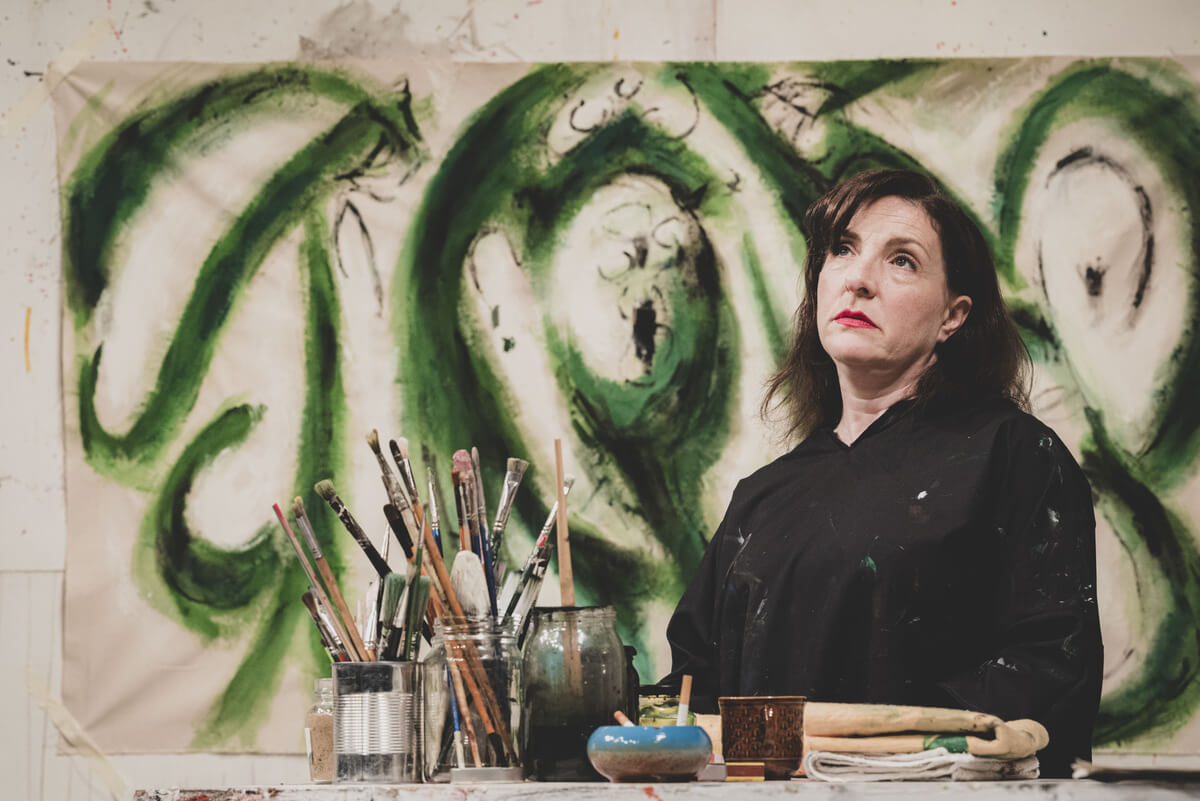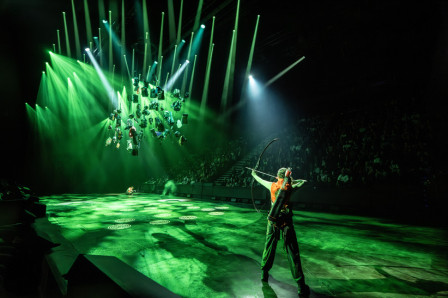Review: LEE at the Park Theatre
History is filled with the overlooked wives of famous men. From Zelda Fitzgerald to Vera Nabokov to Gala Dali, there is an unseen narrative of talented women whose contributions to art and literature were overshadowed by the men in their lives. In Lee, Cian Griffin taps into this narrative to explore the story of Lee Krasner.
 Helen Goldwyn in LEE at the Park Theatre. Photo by Giacomo Giannelli.
Helen Goldwyn in LEE at the Park Theatre. Photo by Giacomo Giannelli.
It’s 1969, thirteen years after the death of the great abstract expressionist artist Jackson Pollack, and his widow Lee Krasner is painting in her Long Island studio when young art student Hank pays her a visit. Taking place over the course of a single morning, their conversation about art takes a startling turn when Hank reveals he’s in possession of a lost painting gifted to his father by Pollack.
The long-dead Pollack, played by Tom Andrews, haunts the narrative, stalking on and off stage with a sneer as he chain-smokes and picks fights with Lee. He is both a ghostly hallucination and a persisting series of memories that overlay the events of the play, so that Lee is sometimes having two simultaneous conversations: verbally sparring with her dead husband in between taking on a reluctant mentor role to the fresh-faced Hank (Will Bagnall), whose earnestness is even more apparent in the face of her cynicism. Helen Goldwyn commands the stage as Lee, playing her with an unimpressed world-weariness and sardonic expressiveness, always quick with a pithy, razor-sharp one-liner.
Ian Nicholas’s set design converts the small, intimate stage into a cluttered, busy studio that draws the eye to every corner, filled with paintings that are recreations of Lee’s actual works. Aside from being a visual thrill, these props become an active part of the play, which opens and closes with Lee working feverishly on a new painting. During emotionally charged moments, Hank often turns to stare into one of the paintings, as if seeking solace in what he sees in Lee's art. A lost painting is the catalyst for the story’s action, and the bulk of the play revolves around a conversation between Lee and Hank about the nature of art, artistic techniques, and the politics of the art world.
It’s fascinating, thought-provoking, and rich with detail - but it does drag in places. It often feels as though we, like Hank, are sitting through a lecture on art, which is gripping for those already interested in the subject, but otherwise starts to feel a bit laborious and exposition-heavy. Similarly, there’s a sense of heavy-handedness when Lee grills Hank about how many female artists he’s been taught about compared to male artists. It’s a crucial point about the sexism inherent in art history, but one which could have been delivered with more of the subtlety and nuance we see across the rest of the play.
Though the interplay between Lee and Hank is the emotional heart of the play, it’s the interactions between Lee and Pollack that really steal the show: vitriolic anger mixed with dizzyingly sharp repartee mixed with genuine moments of poignancy wrapped in a meeting of two genius artistic minds playing off and influencing each other. Art is just a backdrop in the end: this darkly witty and painfully raw play is at its core the (all too familiar) story of a relationship between an egotistical husband struggling with addiction (to alcohol, and also to his own art) and the wife who’s been forced to mother him, at the expense of herself.
Lee is playing at the Park Theatre until October 18th.
Latest News

 GERRY AND SEWELL to transfer to the West End
14 November 2025 at 10:02
GERRY AND SEWELL to transfer to the West End
14 November 2025 at 10:02

 Rehearsal images released for HMS PINAFORE starring Mel Giedroyc
14 November 2025 at 09:29
Rehearsal images released for HMS PINAFORE starring Mel Giedroyc
14 November 2025 at 09:29

 Black Friday Deal: Save up to 60% on London Theatre tickets!
14 November 2025 at 08:00
Black Friday Deal: Save up to 60% on London Theatre tickets!
14 November 2025 at 08:00

 Review Round-Up: THE HUNGER GAMES ON STAGE at Troubadour Canary Wharf Theatre
13 November 2025 at 11:51
Review Round-Up: THE HUNGER GAMES ON STAGE at Troubadour Canary Wharf Theatre
13 November 2025 at 11:51